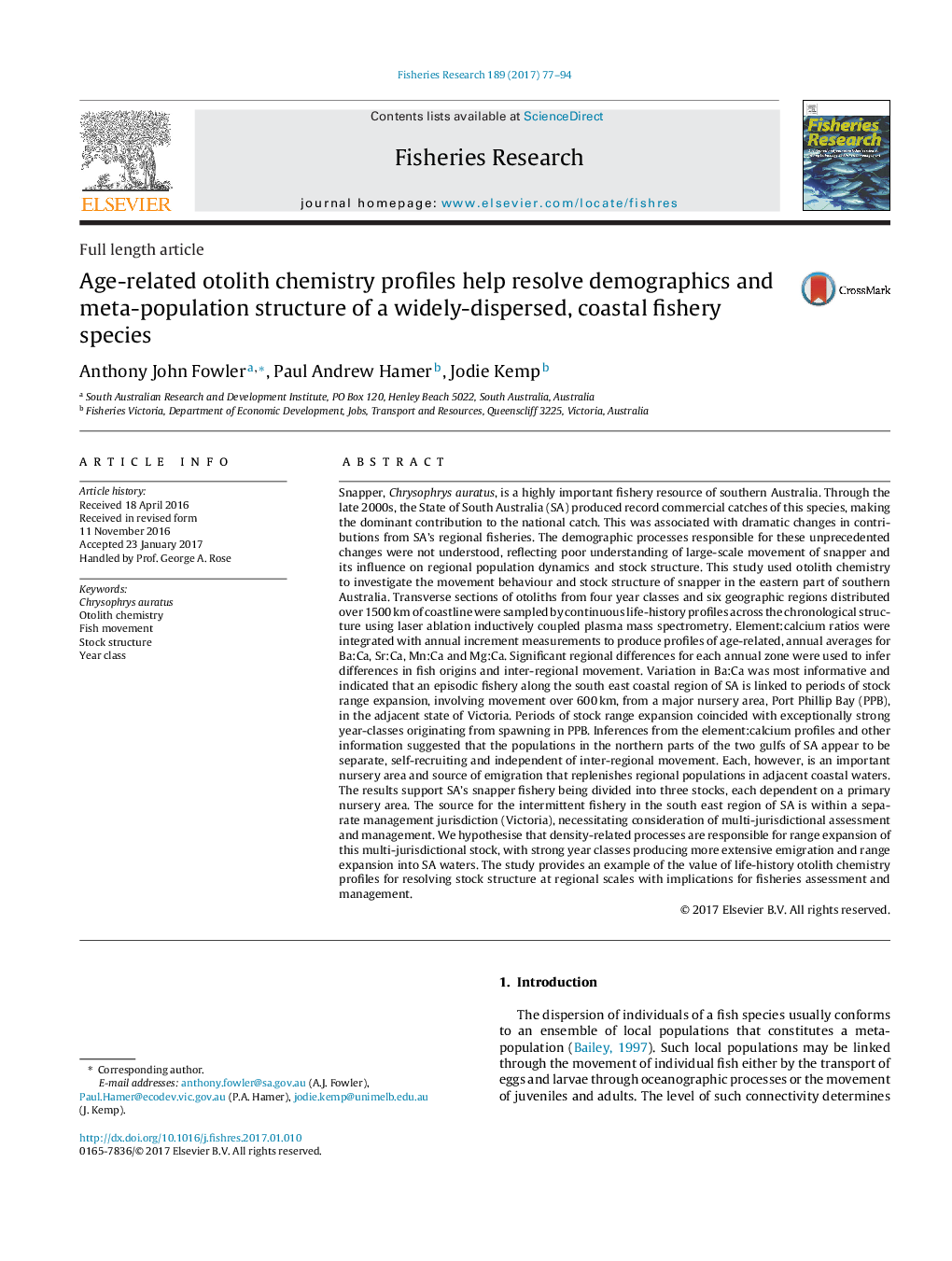| کد مقاله | کد نشریه | سال انتشار | مقاله انگلیسی | نسخه تمام متن |
|---|---|---|---|---|
| 5765534 | 1626781 | 2017 | 18 صفحه PDF | دانلود رایگان |
عنوان انگلیسی مقاله ISI
Age-related otolith chemistry profiles help resolve demographics and meta-population structure of a widely-dispersed, coastal fishery species
ترجمه فارسی عنوان
پروفیل های شیمیایی اوتولیت مرتبط با سن کمک به حل و فصل جمعیت و ساختار جمعیت متشکل از گونه های پراکنده، شیلات ساحلی
دانلود مقاله + سفارش ترجمه
دانلود مقاله ISI انگلیسی
رایگان برای ایرانیان
موضوعات مرتبط
علوم زیستی و بیوفناوری
علوم کشاورزی و بیولوژیک
علوم آبزیان
چکیده انگلیسی
Snapper, Chrysophrys auratus, is a highly important fishery resource of southern Australia. Through the late 2000s, the State of South Australia (SA) produced record commercial catches of this species, making the dominant contribution to the national catch. This was associated with dramatic changes in contributions from SA's regional fisheries. The demographic processes responsible for these unprecedented changes were not understood, reflecting poor understanding of large-scale movement of snapper and its influence on regional population dynamics and stock structure. This study used otolith chemistry to investigate the movement behaviour and stock structure of snapper in the eastern part of southern Australia. Transverse sections of otoliths from four year classes and six geographic regions distributed over 1500Â km of coastline were sampled by continuous life-history profiles across the chronological structure using laser ablation inductively coupled plasma mass spectrometry. Element:calcium ratios were integrated with annual increment measurements to produce profiles of age-related, annual averages for Ba:Ca, Sr:Ca, Mn:Ca and Mg:Ca. Significant regional differences for each annual zone were used to infer differences in fish origins and inter-regional movement. Variation in Ba:Ca was most informative and indicated that an episodic fishery along the south east coastal region of SA is linked to periods of stock range expansion, involving movement over 600Â km, from a major nursery area, Port Phillip Bay (PPB), in the adjacent state of Victoria. Periods of stock range expansion coincided with exceptionally strong year-classes originating from spawning in PPB. Inferences from the element:calcium profiles and other information suggested that the populations in the northern parts of the two gulfs of SA appear to be separate, self-recruiting and independent of inter-regional movement. Each, however, is an important nursery area and source of emigration that replenishes regional populations in adjacent coastal waters. The results support SA's snapper fishery being divided into three stocks, each dependent on a primary nursery area. The source for the intermittent fishery in the south east region of SA is within a separate management jurisdiction (Victoria), necessitating consideration of multi-jurisdictional assessment and management. We hypothesise that density-related processes are responsible for range expansion of this multi-jurisdictional stock, with strong year classes producing more extensive emigration and range expansion into SA waters. The study provides an example of the value of life-history otolith chemistry profiles for resolving stock structure at regional scales with implications for fisheries assessment and management.
ناشر
Database: Elsevier - ScienceDirect (ساینس دایرکت)
Journal: Fisheries Research - Volume 189, May 2017, Pages 77-94
Journal: Fisheries Research - Volume 189, May 2017, Pages 77-94
نویسندگان
Anthony John Fowler, Paul Andrew Hamer, Jodie Kemp,
